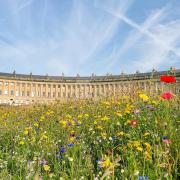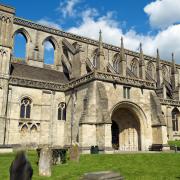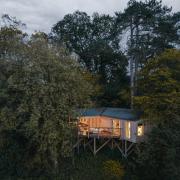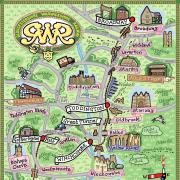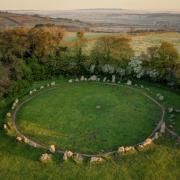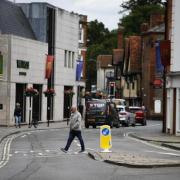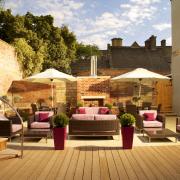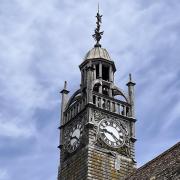Take a closer look at some of the Cotswolds’ quirkiest features in our guide to 10 places throughout the region that will delight visitors of all ages this summer with some unbelievable stories.

Bath
The ladders of angels ascending and descending the West front of Bath Abbey is a stone representation of Jacob’s dream, a story from the book of Genesis in the Bible. Work on this ecclesiastical building started in 1499 and it’s said that the idea to include the angels came to the Bishop of Bath Oliver King while he was sleeping. Take a closer look, and it would appear that the stonemasons employed for the project had differing views as to how descending angels should be depicted. Inside the abbey it’s worth looking up at the beautiful fan vaulting and taking time to read some of the 635 memorials, most of which commemorate people from the 1700s and 1800s, many of whom would have come to Bath to take its famous mineral waters.
* bathabbey.org

Berkeley
Berkeley Castle is a well-known visitor attraction, but don’t leave this historic part of Gloucestershire without calling into the Church of St Mary the Virgin close by for a salutatory lesson from a toad.
You’ll find this plump reptile above the heads of two women, positioned at the junction of two arches inside the building.
This ‘hood-mould corbel’ is said to be a sermon in stone to teach that ‘gossip is like the poisonous tongue of the toad’.

Meanwhile, among the last resting places in the churchyard is a table tomb for one Dicky Pearce, the court jester to the Earl of Suffolk, who was killed during revels at the castle in 1728. It bears an epitaph written by Dean Swift, one time chaplain to Charles, Lord Berkeley:
‘Here lies the Earl of Suffolk’s Fool
Men call’d him Dicky Pearce
His folly serv’d to make folks laugh
When wit and mirth were scarce
Poor Dick alas is dead and gone
What signifies to cry!
Dickys enough are still behind
To laugh at by and by.’

Bisley
Step out of line in or around Bisley between 1824 and the 1850s and temporary confinement in the lock up could have been on the cards. Located the other side of the road to The Bear public house, once the local courthouse in which the magistrate would hear misdemeanours, this stone building with an ogee-shaped parapet topped with a ball finial has two cells, each of which sits behind heavy iron gates. Other highlights of Bisley include All Saints’ Church, which has a font top dating back to Norman times, an effigy of a Crusader and a medieval poor souls’ light once used to hold candles during masses said for those who had nothing.
https://www.bisleyvillage.com

Fairford
There are many reasons to visit St Mary’s Church in Fairford, not least its complete set of late medieval stained glass windows. They include the glorious Great West Window, with Christ at the Last Judgement sitting on a rainbow with the world at his feet and, below him, St Michael judging the souls of the departed. Yet competing with these 500-year-old fenestrations for the attention of visitors is a stone carving of a cat, which sits just outside the church door. Tiddles patrolled the aisles of St Mary’s in search of mice and was a friend to members of the congregation for 17 years between 1963 and 1980. She lived in and around the church and was given a special service by Canon Keble after she died, with her final resting place marked by a local stonemason. Don’t leave the church without looking at the misericords at the east end, which are carved with amusing scenes of domestic medieval life.
* www.stmaryschurchfairford.org.uk

Kelmscott
William Morris urged people to “have nothing in your house that you do not know to be useful, or believe to be beautiful”, and it’s fair to say that his privy qualifies as both.
This grade II-listed closet is housed within a stone structure with a pyramidal stone roof and ball finial, but, contrary to some conclusions, it’s not a three-seater privy. Instead, two of its three sections are thought to have been used for storage of materials such as the cold ashes traditionally thrown into the privy after it had been used.
* kelmscottmanor.org.uk

Malmesbury
People in Malmesbury are still talking about the tiger who came to town in October 1703.
It goes without saying that it was more than likely the first time that people there would have seen such an exotic beast, the star attraction of a travelling circus, but the visit was to end in tragedy when 33-year-old servant woman Hannah Twynnoy died after being savaged by the big cat.
Hannah lies in the churchyard at Malmesbury Abbey, with her final resting place marked with a gravestone that proclaims:
‘In bloom of Life
She’s snatched from hence
She had not room
To make defence;
For Tyger fierce
Took Life away,
And here she lies
In a bed of Clay,
Until the Resurrection Day.’
Life in Malmesbury revolved around the abbey up until The Dissolution, after which it became a woollen factory for some time. One of its stained glass windows depicts a monk holding a pair of wings. This is Elmer, the 11th century member of the Benedictine order who made an early attempt to fly. He made a large pair of wings and launched himself from a tower at the abbey, sustaining two broken legs as a reward. He’s said to have remarked that neglecting to provide himself with a tail was the cause of his failure. Elmer’s flight is commemorated in the name of The Flying Monk Brewery, which has a café and taproom.
www.malmesburyabbey.com

Painswick
Graffiti is nothing new, but the message of the 17th century Puritan soldier who made his mark on a pillar in the North Aisle of St Mary’s Church in Painswick lives on to this day.
‘Be bold, be bold, but not to bold’, thought to be taken from Edmund Spenser’s 1590 work Faerie Queene, was scratched into the stone in 1643 during a disastrous siege of the church when Royalist Sir William Vavousour routed the Puritan forces. Other mementoes from this torrid time include a few holes in the tower made by cannon balls. Don’t leave the churchyard without admiring the fine collection of tombs, including ‘tea caddy’ and even a pyramid, and counting the yew trees, which are said to number 99 because ‘the devil spits on the 100th’. Close to the church is an unusual pair of iron ‘spectacle’ stocks.
* www.stmaryspainswick.org.uk

Stroud
Where would we be without the lawnmower? This essential piece of kit can now be found at homes across the UK, and we have an engineer from Stroud to thank for it. Edwin Beard Budding got the idea for a machine with helical blades to sever blades of grass after seeing the cross-cutter used to trim the fuzzy nap from woollen cloth in local mills. He secured a patent for his ‘machinery for the purpose of cropping or shearing the surfaces of lawns’ in 1830. Amusingly, Budding advertised his invention as an amusing and health exercise for gentlemen. See some of the first Budding mowers, made at the Phoenix Ironworks in Thrupp, at the Museum in the Park, along with an array of other artefacts from the town and surrounding villages. Budding can also be toasted at the Stroud Brewery in Brimscombe, which has named one of its ales in his honour.
* museuminthepark.org.uk

Whichford
Historically the Cotswolds was a celebrated place of industry and this tradition continues in many parts of the region. For a modern day view of craftsmanship and skill, head north to flowerpot specialist Whichford Pottery. Here Adam Keeling and his team are the last few potters able to make jars in which it’s possible to stand, all of which are created by hand on a traditional potter’s wheel. Several of these jars, and Whichford’s range of flowerpots of all sizes and shapes, can be seen at the pottery, which also has a shop and café.
* www.whichfordpottery.com

Woodchester
Owls, dogs and gargoyles are just some of the ornate stone carvings adorning Woodchester Mansion, an unfinished Victorian masterpiece hidden within a beautiful valley. Designed in the Gothic Revival-style by architect Benjamin Bucknall from Rodborough, building work got underway in 1857 but came to a sudden halt in the mid 1860s, leaving missing floors and ceilings, unplastered walls and unglazed windows. This means that all the secrets of the construction of the mansion can be seen, providing a valuable resource for modern-day craftspeople.
* woodchestermansion.org.uk
* When visiting Gloucestershire’s churches, don’t forget to leave a donation towards the upkeep of these precious buildings so that they remain open for others in the future.






